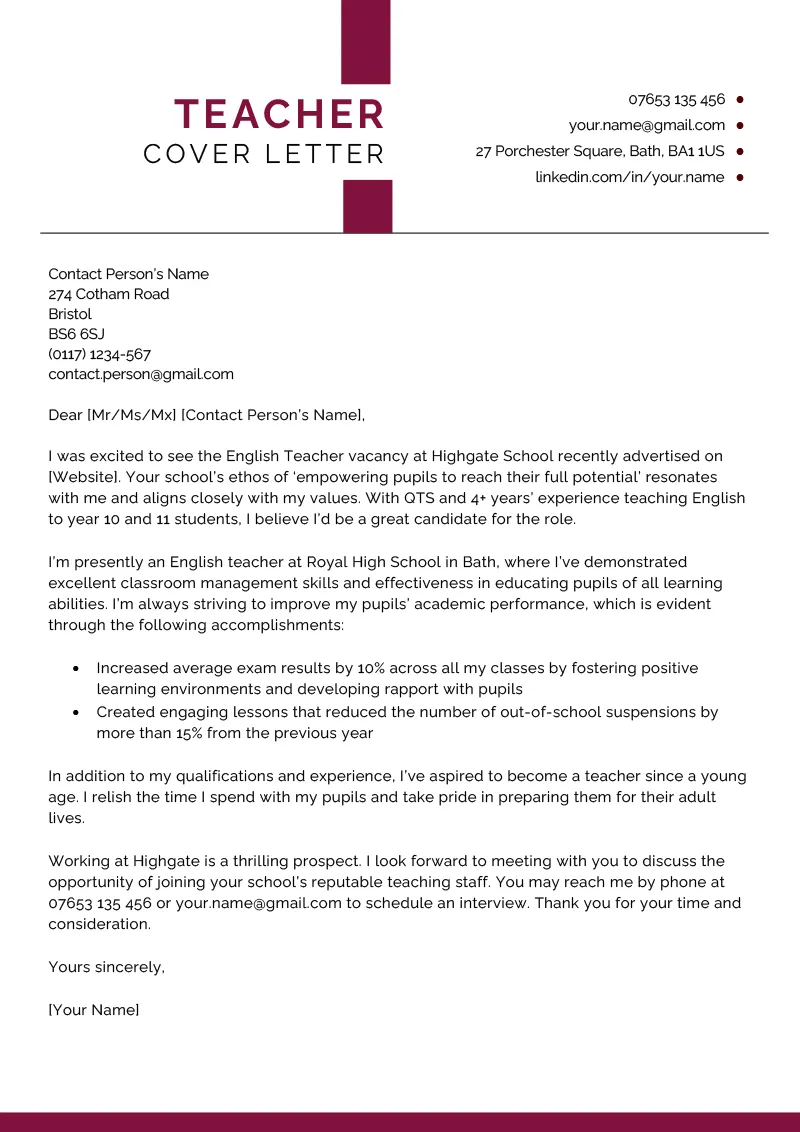Understanding the Purpose of a Teacher Cover Letter
A teacher cover letter is more than just a formality; it’s your first opportunity to make a strong impression and showcase your suitability for a teaching position. Unlike a resume, which provides a factual overview of your experience and qualifications, a cover letter allows you to tell your story. It’s where you articulate your passion for teaching, explain why you’re drawn to a particular school, and highlight the specific skills and experiences that make you the ideal candidate. A well-crafted cover letter should complement your resume, providing context and demonstrating your personality and teaching philosophy. The goal is to persuade the hiring committee that you are not only qualified but also a great fit for their school’s culture and the specific role. The sample cover letter examples serve as a great source of inspiration and guidance.
Key Components of a Teacher Cover Letter
Structuring your cover letter effectively is crucial for capturing the reader’s attention and conveying your message clearly. Several key components are essential for a compelling teacher cover letter. Starting with a professional header containing your contact information and the date is crucial. Next, the letter should address the hiring manager or a specific person whenever possible, demonstrating that you’ve taken the time to research the school. The opening paragraph needs to grab the reader’s attention, state the position you’re applying for, and briefly explain why you are interested in the school and the role. The body of the letter should highlight your relevant qualifications and experiences, using specific examples to illustrate your skills. The closing paragraph should reiterate your enthusiasm, express your interest in an interview, and thank the reader for their time and consideration. Lastly, always proofread your letter thoroughly before submitting it. Review the sample cover letter examples to use them as a guide.
Header and Contact Information

The header of your teacher cover letter should include your full name, address, phone number, and email address. Ensure this information is accurate and professional. The date should follow, placed below your contact details. The use of a professional email address is important; avoid using nicknames or unprofessional email handles. Consider using a simple, clean format for your contact information to ensure it’s easy to read. This part of the letter should be formatted consistently with your resume, presenting a professional image from the start. Also, it is helpful to have your resume attached, to support all the information that is mentioned on the letter. This is the first impression, so take your time to make it perfect.
Addressing the Hiring Manager
Whenever possible, address your cover letter to a specific person. This demonstrates that you’ve taken the initiative to research the school and shows that you’re invested in the application process. Use the hiring manager’s name if available; otherwise, you can address it to the principal, the human resources department, or the hiring committee. You can usually find the name of the hiring manager on the school’s website or in the job posting. If you are unable to find a specific name, use a professional salutation such as “Dear Hiring Committee” or “Dear Principal.” Using a specific name personalizes the letter and makes it more likely to capture the reader’s attention. Always double-check the spelling of the recipient’s name.
The Opening Paragraph
The opening paragraph is your chance to make a strong first impression. Begin by stating the position you’re applying for and where you found the job posting. Briefly explain why you are interested in the school and the specific role. If you have a connection to the school or district, mention it here. The opening should be concise, engaging, and directly address the reader’s needs. For example, you might start with a statement about your passion for education, a brief summary of your experience, or a mention of a specific program or value that resonates with you. A great opening paragraph will capture the reader’s attention and make them want to read more about your qualifications. It sets the tone for the rest of your letter.
Highlighting Your Qualifications

This section of your cover letter is where you highlight your relevant qualifications and experiences. Focus on the skills and experiences that are most relevant to the specific teaching position you’re applying for. Use the job description to identify the key requirements and tailor your examples to match. Be specific and provide concrete examples of how you have demonstrated these skills in the past. Quantify your achievements whenever possible. For instance, mention the number of students you taught, the improvements in student test scores, or any successful projects you’ve implemented. Provide details about your teaching philosophy and how you approach classroom management, curriculum development, and student engagement. Referencing the sample cover letter examples will give you the best possible guidance.
Showcasing Relevant Experience
When showcasing your experience, focus on the roles and responsibilities that are most relevant to the teaching position. Highlight experiences that demonstrate your ability to create a positive and effective learning environment. If you’ve held previous teaching positions, describe your successes and the impact you had on students. Mention any specific programs or initiatives you led or participated in. If you’re a recent graduate or have limited teaching experience, highlight your student teaching experience, volunteer work, or any other activities that demonstrate your skills and passion for teaching. Be specific about your role and the outcomes achieved. Also, showcase any professional development activities that you have accomplished.
Quantifying Achievements
Quantifying your achievements in your cover letter can make a significant impact on the hiring committee. Use numbers and data to demonstrate your effectiveness and the positive outcomes you’ve achieved. Instead of saying you improved student engagement, specify the percentage increase. Instead of saying you improved student test scores, provide the exact scores or the percentage of students who met or exceeded standards. If you developed new curriculum materials, mention how many units or lessons you created. When describing your accomplishments, always focus on the results and benefits for the students and the school. This will help the hiring committee understand the value you can bring to their school. Review the sample cover letter examples to see how they do this.
Emphasizing Skills and Abilities
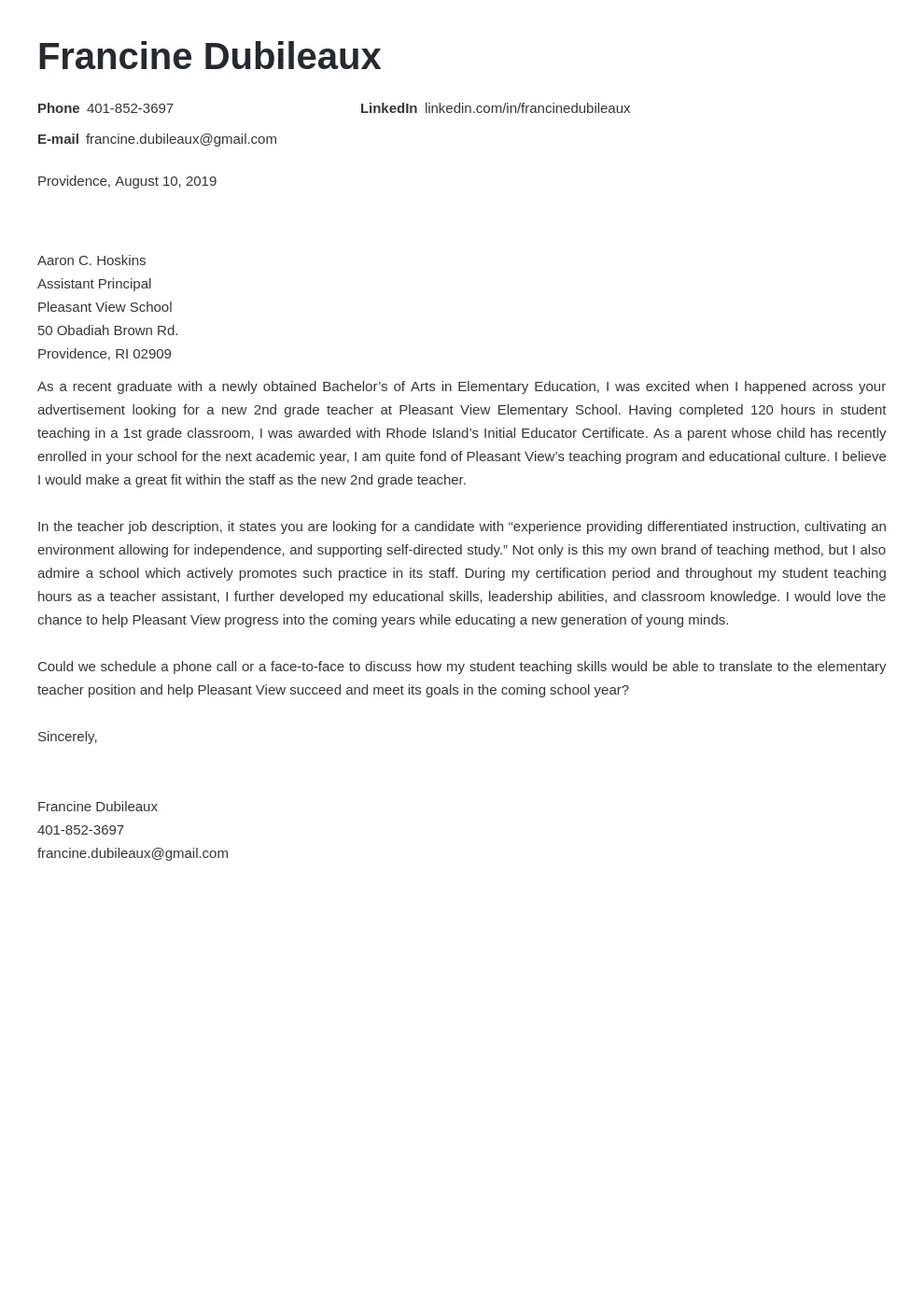
In addition to showcasing your experience, it’s important to highlight your key skills and abilities in your cover letter. Tailor your skills to match the requirements of the job posting. Focus on those that are most relevant to the specific teaching position. Provide specific examples of how you have demonstrated those skills in the classroom. Your letter should emphasize skills like classroom management, curriculum development, and communication. In the following sections, explore these skills in detail. This section shows the employer the expertise and personality that would be very beneficial to the position.
Classroom Management
Demonstrate your classroom management skills by describing your approach to creating a positive and organized learning environment. Mention strategies you use to establish clear expectations, maintain student engagement, and manage disruptive behavior. Provide examples of specific techniques you have used to create a supportive and inclusive classroom where students feel safe and respected. If you’ve implemented any specific classroom management systems or programs, describe them. Make sure to emphasize your ability to build positive relationships with students and create a collaborative learning atmosphere. Your classroom management philosophy will be a crucial element of the application.
Curriculum Development
Highlight your curriculum development skills by describing your experience in designing and implementing lesson plans, assessments, and educational materials. Mention any specific curriculum models or frameworks you’re familiar with, such as Common Core or Next Generation Science Standards. Provide examples of innovative teaching methods you have used to engage students. If you have created any new curriculum units or adapted existing ones, describe the process and the impact they had on student learning. Show your ability to align your curriculum with the school’s goals and the needs of the students. Be sure to show that you have a deep understanding of educational best practices.
Communication and Collaboration
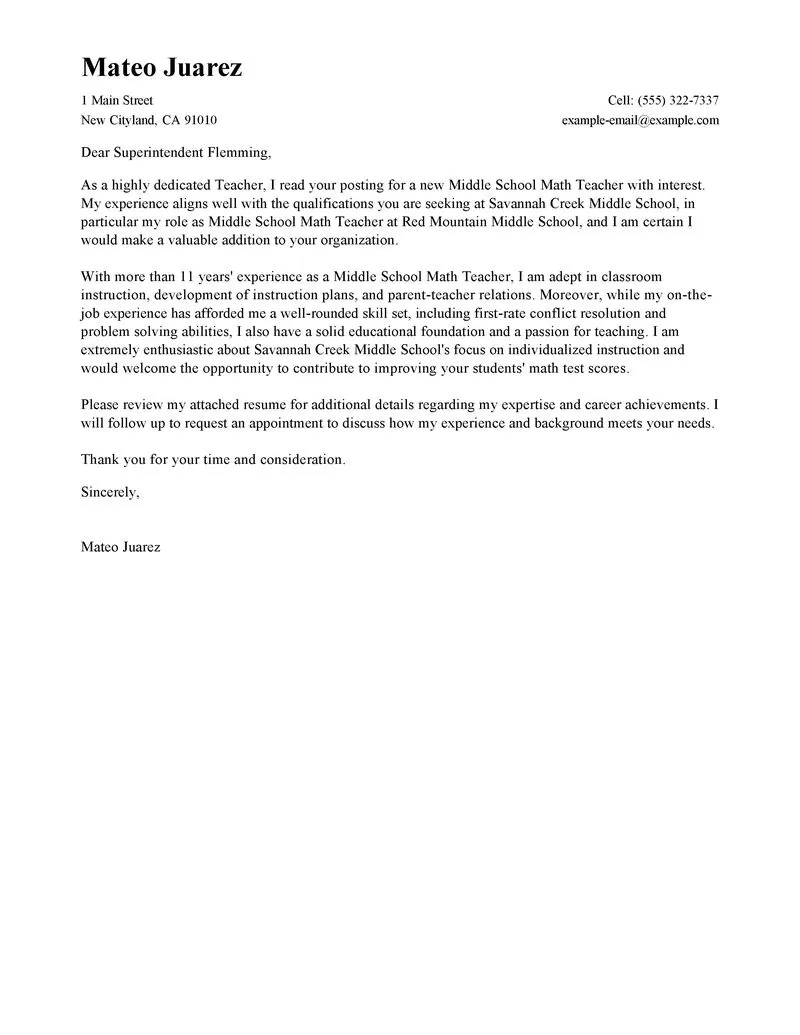
Effective communication and collaboration are essential for successful teaching. Emphasize your ability to communicate clearly and effectively with students, parents, and colleagues. Provide examples of your experience in working collaboratively with other teachers, administrators, and support staff. Mention any experience you have in communicating with parents about student progress and behavior. Describe your ability to build strong relationships and create a positive school environment. Highlighting your communication skills shows that you’re a team player who can create a supportive and inclusive learning environment.
Tailoring Your Letter to the School
Tailoring your cover letter to the specific school you’re applying to is a critical step in the application process. It shows the hiring committee that you’ve taken the time to research the school and understand its values, mission, and educational philosophy. Customize your letter to reflect the school’s unique characteristics and demonstrate how your skills and experience align with their needs. By highlighting your knowledge of the school’s culture and values, you will be much more likely to stand out from the crowd. Therefore, the sample cover letter examples serve as a guide.
Researching the School and its Values
Before writing your cover letter, thoroughly research the school. Visit their website to learn about their mission, values, and educational programs. Read about the school’s history, culture, and any specific initiatives they have. Review the school’s social media accounts and any news articles or publications about the school. Identifying the school’s priorities, such as a focus on technology integration, a commitment to diversity and inclusion, or a specific teaching approach. This research will help you tailor your letter to match the school’s unique characteristics and demonstrate your understanding of its values. Make sure you incorporate your findings in your letter, so it is customized to the school.
Demonstrating Alignment with School’s Mission
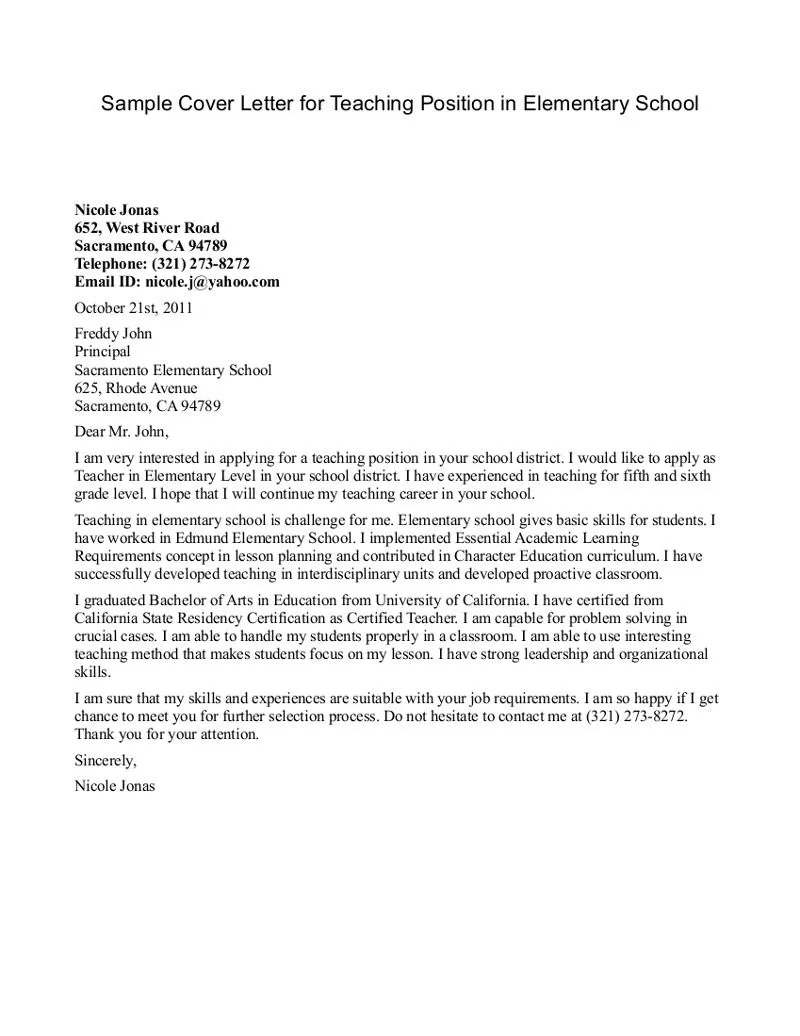
Demonstrate your alignment with the school’s mission and values by clearly stating how your teaching philosophy and experience align with their goals. Use the school’s mission statement to guide your writing. Reference the specific values and programs that resonate with you. Provide examples of how your teaching practices reflect the school’s commitment to student success, innovation, or community engagement. If the school emphasizes a specific teaching method, like project-based learning, highlight your experience and passion for that approach. Demonstrating your understanding of the school’s mission and values will show the hiring committee that you’re a good fit for their school culture. Tailoring the letter to the school is essential.
Writing a Strong Closing
The closing paragraph of your cover letter is your final opportunity to leave a lasting impression. It should reiterate your enthusiasm for the position and express your interest in an interview. Keep the closing concise, positive, and professional. It should summarize your key qualifications and re-emphasize your interest in the role. Thank the reader for their time and consideration, and include your contact information once again. The closing should leave the reader with a clear understanding of why you’re the best candidate for the job.
Expressing Enthusiasm and Interest
Express your enthusiasm and genuine interest in the position and the school. Mention something specific that excites you about the opportunity. Show that you have done your research and that you are truly interested in being part of their team. Avoid generic statements; personalize your closing to show your genuine interest. For example, you might express your excitement about contributing to a specific program or being part of a school with a strong community. The sample cover letter examples help you do this.
Call to Action
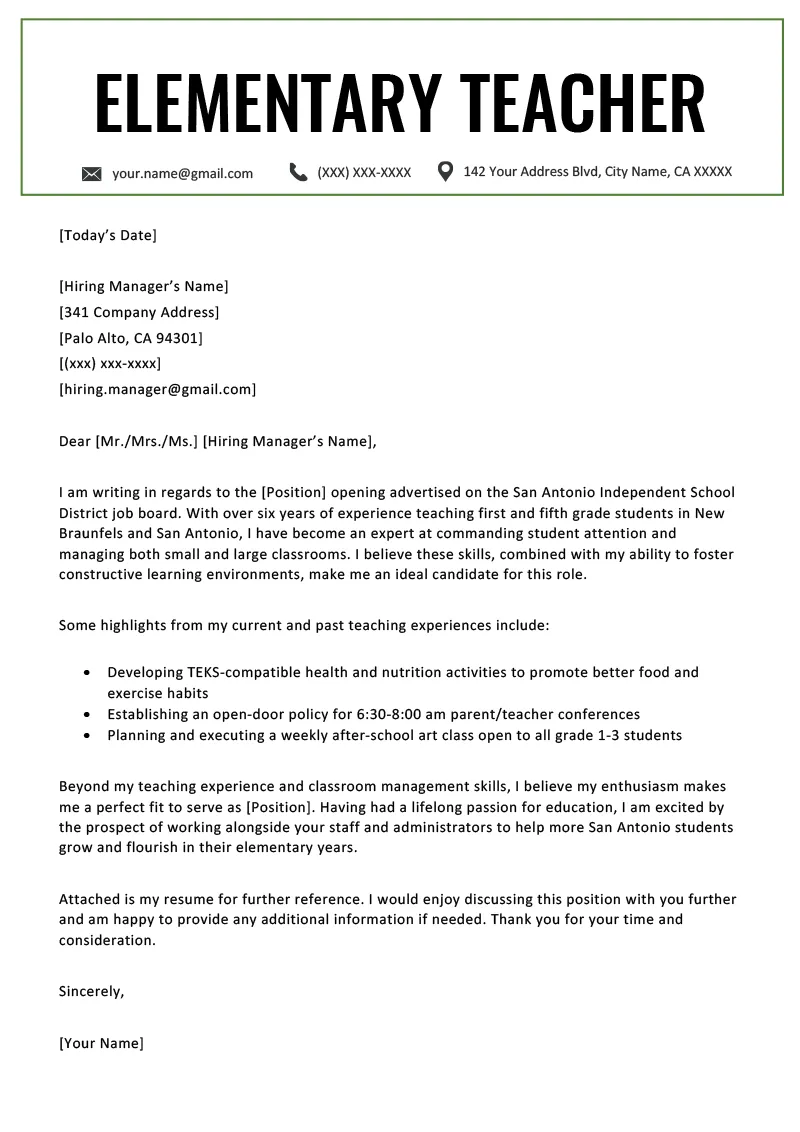
Include a clear call to action in your closing paragraph. Express your willingness to interview and provide your contact information. State that you are available to discuss your qualifications further and look forward to hearing from them soon. Make it easy for the hiring manager to contact you. Restate your contact details, including your phone number and email address. This will leave the employer with an actionable next step to take.
Proofreading and Formatting
Before submitting your cover letter, proofread it carefully for any errors in grammar, spelling, and punctuation. Errors can create a negative impression and undermine your credibility. Proofread your letter multiple times, or have someone else review it. Pay attention to sentence structure, word choice, and overall clarity. Formatting is also important. Use a professional font, such as Times New Roman or Arial, and maintain consistent formatting throughout your letter. Ensure that your letter is easy to read and visually appealing. The sample cover letter examples should guide you, especially with the formatting. The goal is to impress the hiring committee.
Tips for Proofreading
When proofreading your cover letter, pay close attention to detail. Read your letter aloud to catch any awkward phrasing or grammatical errors. Use a spell checker and grammar checker, but don’t rely on them completely. Review your letter multiple times, each time with a fresh perspective. Check for consistency in formatting, such as spacing and font size. Ask a friend, family member, or career counselor to review your letter as a final check. A second set of eyes can often catch errors that you might miss. Ensure the letter is free of errors, for a positive impression.
Formatting for Readability
Format your cover letter for readability to make it easy for the hiring manager to read and understand. Use a professional font, such as Times New Roman or Arial, in a standard size (11 or 12 points). Use a clear and concise layout with ample white space. Break up long paragraphs into shorter ones to make the text less dense. Use bullet points to highlight key skills and accomplishments. Make sure your margins are consistent. Ensure there is an appropriate amount of space between paragraphs and sections. A well-formatted cover letter is easier to read and shows attention to detail.
